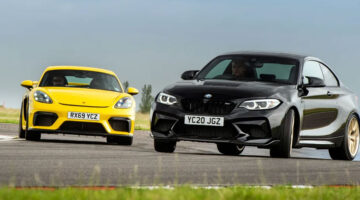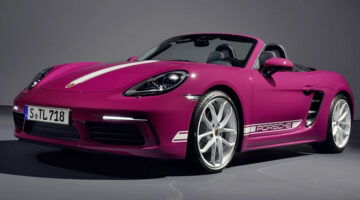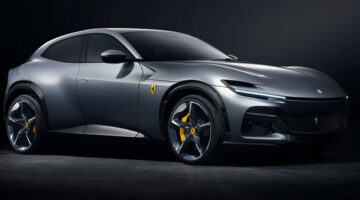Let’s start with the Audi. Rather bizarrely, when cruising in Normal mode, the awesome 450hp power doesn’t rattle your spine from its moorings as we’d expected. Long gear ratios in the seven-speed Tiptronic S automatic gearbox pull hard but are less than snappy . It’s a similar story in the Porsche, whose eight-speed PDK box – and, hurrah(!), proper paddle shifters – works in much the same way. Considering the performance figures at our disposal, it’s all very underwhelming. This proves a particularly harsh double-edged sword for the Porsche. A 2085kg kerb weight means getting the SUV moving requires a couple of stirrups to the 420 horses.
Switch the drive modes to Sport however, and this unleashes a whole new animal. In the Porsche the top two gears are negated, its 420hp now being channelled by the bottom six gears and consequently offering more aggressive acceleration. Lower acceleration is still a little muted, since peak torque doesn’t come in before 3500rpm. It’s hardly slow though, acceleration building sprightly before topping out at 6500rpm. Hustle the loud pedal above that and you’re greeted with a superb bass from the Sound Symposer system, which channels engine notes into the cabin. It’s a wonderfully beefy sound, indicative of driving any Porsche and immediately sets the hairs on the back of your neck on edge. Knock the gearbox up and the notes build again. Though smooth in Normal, changes in Sport are much more aggressive, rocking the cabin gently as another cog is slotted, and rearing the nose upwards.
By comparison, the Audi is in a different league: while acceleration in the GTS is aggressive, in the RS4 it’s downright violent. Plant the right foot and remapped engine and gearbox settings punch the bonnet skywards, a lurch signifying the power being directed through all four wheels. No turbo means acceleration is linear and staggeringly quick to hit the redline, despite a moderately chunky 1795kg kerb weight. Flicking the gears through the wheel-mounted paddle shifters and an upshift happens almost instantly, the dual clutch working superbly behind the scenes to keep the acceleration brutal.
The speed will make your eyes roll back but that’s not what sticks with me. That would be the growl from the V8. Impressive acoustic levels in the cabin mean it’s even better than the Porsche, a throaty VRAAAAAAR giving way to a deep-throated burble on the overrun when the next gear is slotted home. It’s a magnificent sound that gets the blood pumping, and you’ll find it hard to resist.
Points to the Audi then, though the Porsche has a significant ace up its green sleeve. There’s still lean – it would be ungracious to expect otherwise from an SUV – but active stabilisers in Porsche’s Dynamic Chassis Control work to negate bodyroll while cornering, significantly improving the balance. It’s very impressive. Throw the GTS at a corner and you’ll be surprised how planted it remains, massive grip from the Michelin Pilot Sports preventing the front end from washing. Were it not for my own concerns about tipping over, I’d be pushing the Cayenne yet further than I already am. At low speeds the electronic steering can prove heavier than ideal but there’s considerable heft to keep you connected to the front end.
There is an issue though, one linked deeply to the SUVs DNA and a reminder of which comes through the brakes. Our test model uses the Ceramic Composite Brake system, which improves the feel and wear of the discs. There’s little travel in the pedal and more than enough response to keep you connected. Throw out the anchors though and the 2805kg (which at speed you’ll hardly notice) does make itself known, pushing itself over the front axle. The GTS is certainly very good when grabbed by the scruff of the neck, but it’s difficult to forget that despite energetic running an SUV is rarely intended for it.
STORY CONTINUES ON PAGE 3 – FULL GALLERY OF SHOTS AVAILABLE HERE – CLICK –



